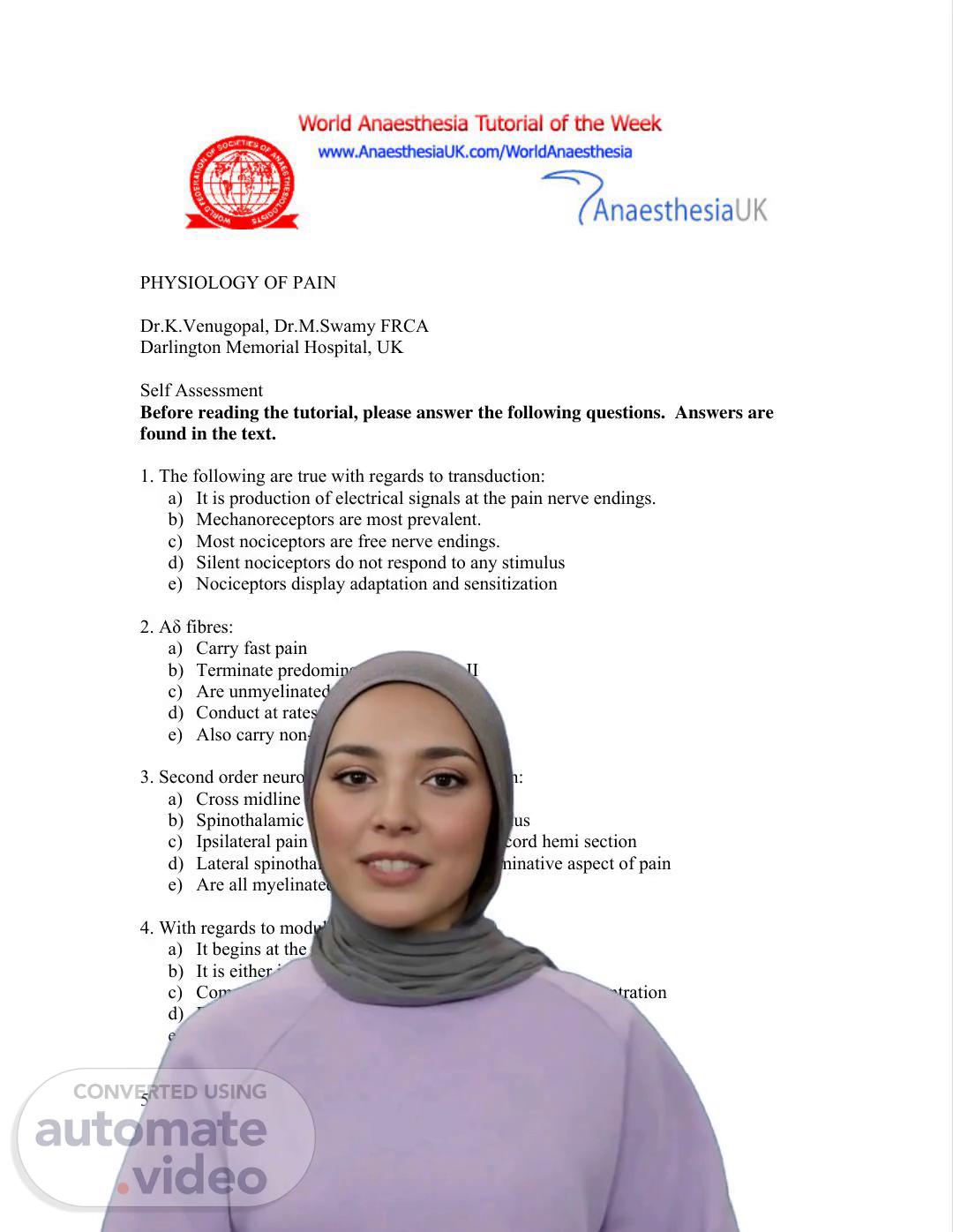Scene 1 (0s)
[Virtual Presenter] The production of electrical signals at pain nerve endings. Carry fast pain. Cross midline anterior to central canal. Begins at the dorsal horn of spinal cord. The flexor reflex..
Scene 2 (12s)
[Audio] physiology of pain including transduction of pain, roles of Aδ fibres and second order neurons, modulation and reflex responses to pain. a) Increased myocardial work b) Urinary incontinence c) Decreased testosterone d) Hyperglycaemia e) Increased fibrinolysis.
Scene 3 (28s)
[Audio] Dorsal horn cells are also called gate cells because of their ability to modify pain impulses, known as gating. Nociceptive-specific neurons respond only to noxious stimuli and are arranged somatotopically in lamina I Wide dynamic range (W-D-R--) neurons receive both noxious and non-noxious afferent input from Aβ, Aδ and C fibres. Central transmission occurs as axons of most second order neurons cross the midline at the anterior commisure to the contralateral side of the spinal cord to ascend as the spinothalamic tract ending in the thalamus, reticular formation, nucleus raphe magnus and the periaqueductal gray. Both lateral and medial spinothalamic tracts project to the thalamus. Perception occurs as third order neurons are located in the thalamus and project to somatosensory areas II and I in the post-central gyrus and superior wall of the sylvian fissure. Some fibres project to the anterior cingulated gyrus and mediate the suffering and emotional components of pain..
Scene 4 (1m 32s)
[Audio] Pain is a complex experience that involves both peripheral and central modulation. Peripheral modulation of pain can occur through primary hyperalgesia and secondary hyperalgesia/neurogenic inflammation. Primary hyperalgesia occurs when peripheral nociceptors become sensitized, resulting in decreased threshold, increased frequency response, decreased response latency, and spontaneous firing. This is mediated by the release of algogens from damaged tissues. Secondary hyperalgesia, or neurogenic inflammation, is due to the antidromic release of substance P from collateral axons of primary afferent neurons. This degrades histamine and serotonin, vasodilates blood vessels, causes tissue edema, and induces the formation of leukotrienes. Central modulation of pain can either facilitate or inhibit it. The mechanisms for facilitation include windup, sensitization of second order neurons, receptive field expansion, and hyper excitability of flexion responses. Neurochemical mediators of central sensitization include substance P, C-G-R-P-, V-I-P--, cholecystokinin, angiotensin, galanin, L-glutamate, and L-aspartate. These substances trigger changes in membrane excitability. Inhibitory mechanisms of central modulation can occur, which can be either segmental or supraspinal. Segmental inhibition involves the activation of large afferent fibres subserving epicritic sensation inhibitory W-D-R neuron and spinothalamic activity. Glycine and γ-amino butyric acid (G-A-B-A-) are amino acids that function as inhibitory neurotransmitters. Segmental inhibition appears to be mediated by GABAb receptor activity, which increases K plus conductance across the cell membrane. Supraspinal inhibition occurs when several supraspinal structures send fibres down the spinal cord to inhibit pain at the level of the dorsal horn. These include periaqueductal gray, reticular formation, and nucleus raphe magnus (N-R-M--). Axons from these structures act pre-synaptically on the primary afferent neurons and post-synaptically on second-order neurons (or interneurons). These inhibitory pathways utilize monoamines, such as noradrenaline and serotonin, as neurotransmitters and terminate on nociceptive neurons..
Scene 5 (4m 1s)
[Audio] We hope that this information has been informative and helpful in understanding the mechanisms involved in pain recognition, transmission, and perception. As we have discussed, pain can have both beneficial and harmful effects on the body, and a better understanding of its physiology can aid in the development of effective strategies for managing and treating pain..
